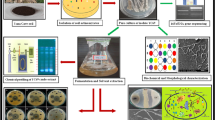Abstract
One culture ofF avenaceum, 4 cultures ofF oxysporum, and 11 cultures of Fsambucinum were isolated from soil samples of pasture in New Zealand in 1987. All cultures, when grown on rice media and fed to rats caused a weight loss in rats as well as toxic signs including hemorrhaging and congestion, uterine enlargement, and hematuria. 6 out of 16 cultures caused death in rat feeding tests.F oxysporum #1 killed rats (feeding test) within 5-12hrs. 10 cultures produced zearalenone (19 to 8,849 ppm), 8 cultures produced nivalenol (32 to 117 ppm), 1 culture,F sambucinum #8, produced wortmannin (40 ppm), and 5 cultures produced moniliformin (19 to 9,000ppm). We report for the first time the co-occurrence of zearalenone, nivalenol, and moniliformin produced byF sambucinum #3 in culture.F avenaceum #1 andF oxysporum cultures (nos 1, 2, and 3) produced moniliformin alone.F oxysporum #4 produced zearalenone alone as well.F sambucinum #5 caused erythema in the small intestine of rats and 100% mortality and did not produce any known toxin(s). Nivalenol when administered to the stomach of rats orally at levels 10, 20, and 40mg/kg body weight caused inflammation in the intestines, coma, and death. The mycotoxins T-2 toxin, HT-2 toxin, T-2 tetraol, diacetoxyscirpenol (DAS), monoacetoxyscirpenol (MAS), deoxynivalenol (DON), 3-acetyl-and 15-acetyldeoxynivalenol, depoxynivalenol, fusarenon-X, alpha-and beta-zearalenone, and fusarochromanone (TDP-1) were not detected in the extracts of these cultures.
Similar content being viewed by others
References
Abbas HK, Mirocha CJ (1988) Isolation and purification of a hemorrhagic factor (Wortmannin) fromFusarium oxysporum N17B. Appl Environ Microbiol 54:1268–1274
Abbas HK, Mirocha CJ (1988) Production of Fusarenon-X, nivalenol, and zearalenone byGibberella zeae isolates, and their toxicity in fibroblasts and rats. Mycotox Res 4:67–72
Abbas HK, Mirocha CJ, Gunther R (1989) Mycotoxins produced by toxicFusarium isolates obtained from agricultural and nonagricultural areas (Arctic) of Norway. Mycopath 105:143–151
Abbas HK, Mirocha CJ, Vesonder RF, Gunther R (1990) Acute toxic effects of an isolate of moniliformin-producingFusarium oxysporum and purified moniliformin on rats. Arch Environ Contam Toxicol 3:433–436
Allen NK, Burmeister HR, Weaver GA, Mirocha CJ (1981) Toxicity of dietary and intravenously administered moniliformin to broiler chickens. Poult Sci 60:1415–1417
Bosch U, Mirocha CJ, Abbas HK, di Menna M (1989) Toxicity and toxin production byFusarium isolates from New Zealand. Mycopathologia 108:73–79
Burmeister HR, Grove MD, Kwolek WF (1980) Moniliformin and butenolide: Effect on mice of high-level, long-term oral intake. Appl Environ Microbiol 40:1142–1144
di Menna ME, Lauren DR, Holland PT (1985) Presence of zearalenone in New Zealand pasture leaves. NZ Vet J 33:193
Gallaghar RT (1985) On the oestrogenic mycotoxin zearalenone, and the pasture fungusFusarium culmorum. NZ Vet J 33:37–38
Gunther R, Abbas HK, Mirocha CJ (1989) Acute pathologic effects of orally administered wortmannin fromFusarium oxysporum. Fd Chem Toxic 27:173–179
Gunther R, Kishore PN, Abbas HK, Mirocha CJ (1989) Immunosuppressive effects of dietary wortmannin on rats and mice. Immunopharmacology and Immunotoxicology 11:559–570
Kelly RA, Knight TW (1979) Sources of reproductive failure in commercial sheep flocks. Proceedings Ruakura Farmer’s Conference 19–26
Lamprecht SC, Marasas WFO, Thiel PG, Schneider DJ, Knox-Davies PS (1980) Incidence and toxigenicity of seedborneFusarium species from annualMedicago species in South Africa. Phytopath 76:1040–1042
Lee YW, Mirocha CJ (1984) Production of nivalenol and fusarenone-X byFusarium tricinctum Fn-2B on a rice substrate. Appl Environ Microbiol 48: 857–858
Mirocha CJ, Christensen CM, Nelson GH (1971) F-2 (zearalenone) estrogenic mycotoxin fromFusarium. pp 107–138.In: Microbial Toxins. Kadis S, Ciegler A, Ajl SJ (eds), vol 7, Academic Press, Inc, New York
Mirocha CJ, Abbas HK (1989) Chemistry, occurrence and toxicology of the hemorrhagic mycotoxin (wortmannin) produced byFusarium, pp 213–221.In: Mycotoxins and Phycotoxins 88, Natori S, Hashimoto K, Ueno Y (eds), Elsevier
Mirocha CJ, Abbas HK, Kommedahl T, Jarvis BB (1989) Mycotoxins production byFusarium oxysporum andFusarium sporotrichioides isolated fromBaccharis spp from Brazil. Appl Environ Microbiol 55:254–255
Nash S, Snyder WC (1962) Quantitative estimations by plate counts of propagules of the bean root rotFusarium in field soils. Phytopath 52:567–572
Nelson PE, Toussoun TA, Marasas WFO (1983)Fusarium species (an illustrated manual for identification). The Pennsylvania State University Press, University Park, 1–193
Ryu J-C, Tashiro F, Kanzaki N, and Ueno Y (1986) Toxicological studies on nivalenol (1). Lethal toxicity in mice and cytotoxicity to cultured cells. Proc Jpn Assoc Mycotoxicol 24:31–34
Ryu J-C, Ohtsubo K, Izumiyama N, Nakamura K, Tanaka T, Yamamura H, and Ueno Y (1988) The acute and chronic toxicities of nivalenol in mice. Fund Appl Toxicol 11:38–47
Scott PM, Lawrence GA (1987) Liquid chromatographic determination and stability of theFusarium mycotoxin moniliformin in cereal grains. J Assoc Offic Anal Chem 70:850–853
Smith JF, di Menna ME, McGowan LT (1986) Effect ofFusarium culture and zearalenone on the reproductive performance of ewes. Proceeding of New Zealand Soc Anim Prod 46:255–258
Tanaka T, Hasegawa A, Yamamoto S, Lee U-S, Sugiura Y, Ueno Y (1988) Worldwide contamination of cereals by theFusarium mycotoxins nivalenol, deoxynivalenol, and zearalenone. I. Survey of 19 countries. J Agric Food Chem 36:979–983
Tanaka T, Hasegawa A, Yamamoto S, Sugiura Y, Ueno Y (1988) A case report on a minor contamination of nivalenol in cereals harvested in Canada. Mycopath 101:157–160
Thiel PG, Meyer CJ, Marasas WFO (1982) Natural occurrence of moniliformin together with deoxynivalenol and zearalenone in Transkeian corn. J Agric Food Chem 30:308–312
Thiel PG, Gelderblom WCA, Marasas WFO, Nelson PE, Wilson TM (1986) Natural occurrence of moniliforrnin and fusarin C in corn. Screenings known to be hepatocarcinogenic in rats. J Agric Food Chem 34:773–775
Ueno Y, Fukushima K (1968) Inhibition of protein and DNA synthesis in Ehrlich ascites tumor by nivalenol, a toxic principle ofFusarium nivale-growing rice. Experientia 24:1032–10330
Vesonder RF (1986) Moniliformin produced by cultures ofFusarium moniliforme varsubglutinans isolated from swine feed. Mycopath 95:149–153
Warcup JH (1950) The soil-plate method for isolation of fungi from soil. Nature 166:117–118
Author information
Authors and Affiliations
Rights and permissions
About this article
Cite this article
Abbas, H.K., Mirocha, C.J. & Gunther, R. Production of zearalenone, nivalenol, moniliformin, and wortmannin from toxigenic cultures ofFusarium obtained from pasture soil samples collected in New Zealand. Mycotox Res 7, 53–60 (1991). https://doi.org/10.1007/BF03192166
Received:
Accepted:
Issue Date:
DOI: https://doi.org/10.1007/BF03192166




